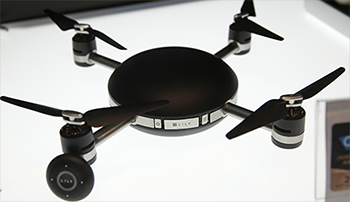Tomorrow’s Drones Are Amazing, but Obstacles Exist Written 17 June 2016

Credit: Associated Press–©
by David Hodes, Aerospace America contributing writer
Speakers: Andy Lacher, UAS integration research strategist, Mitre; Dale Richards, senior research fellow in human factors, Coventry University
Drones that essentially fly themselves are available now, but there are obstacles, and the future needs humans working with drones, experts said June 16 at the 2016 AIAA Demand for Unmanned Symposium in Washington, D.C.
In the panel, “Visions of the Future,” Andrew Lacher, UAS integration research strategist for Mitre, showed examples of what the future of drones looks like.
First was a drone from Lily, a camera company. He said it’s essentially a flying selfie stick that follows its subject based on criteria the subject programs into a special wrist watch. Though, according to Lacher, the aircraft is really flying itself as it follows its subject.
“This aircraft is picking its flight path, its speed and direction, working to counter wind, and will land itself when it detects that the battery is running low,” Lacher explained.
Another example was the fixed-wing PrecisionHawk robotic airplane. He said the company views itself more as a seller of data than a drone manufacturer because it uses the plane’s camera to gather pictures and other data for agriculture and other similar uses.
Lacher said overall, there is a need to make operating unmanned aerial systems simpler.
“We want to lower user sophistication — make these aerial systems easier to operate so that there is less training on how to use them,” Lacher said. “There is more automation needed in the system, but it needs to still work as a team with a human.”
Dale Richards, senior research fellow in human factors at Coventry University, said U.K. drone rules are similar to the rules in the U.S. (except for maximum flying altitude, which is 400 feet in the U.K. and 500 feet in the U.S.).
“But they consider the users as pilots and not operators,” he said of U.K. rules. “I don’t think that is going to work.”
Lacher said what is really needed is pilotless aircraft, which he called “the future.”
The discussion also touched on autonomous cars. Lacher cited the time a Google autonomous car was pulled over for driving too slowly and the time it faced a woman in an electric wheelchair chasing a duck in the middle of the road.
“It’s these non-normative conditions that need to be thought about,” Lacher said.
 |
| All 2016 AIAA AVIATION Forum Videos |
